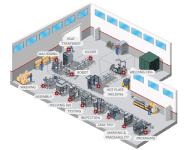
Vision inspection systems incorporate automation, cameras, and sensors to speedily and reliably assist with process monitoring and product inspections in various applications. By integrating such systems into your production and assembly lines, it’s easier to ensure and maintain quality across your operation.
What Are Vision Inspection Systems?
Vision inspection systems rely on a combination of cutting-edge software, and vision systems to inspect goods during processing and production. They incorporate visual inspection automation technology and sometimes robotics to enhance tracking capabilities and quality assurance.
These systems have widespread applications, including but not limited to:
- All-in-one smart cameras
- 3D scanning
- High-speed controllers for 2D, 3D, and line scan camera systems
- AI- and rule-based vision tools
- Vision-guided robots
- Lighting, lenses, and peripheral systems for basic optimal image generation
- Barcode reading
- Standard and laser microscopes
- Safety laser controllers and scanners
- Photoelectric, laser, and fiber optic sensors
- Measurement sensors
- Product and part marking and coding
As manufacturing and assembly operations become increasingly complex, dependable vision system inspections are becoming essential to effectively monitor and evaluate quality, trace and serialize products, and more.
Pros and Cons of Vision Inspection Systems
Vision inspection systems come with benefits and disadvantages, outlined below to help you determine if these systems are right for your application and operation.
Pros
Some of the advantages of using vision inspection systems include:
- Optimized Efficiency: Automated inspections increase efficiency by replacing manual processes, allowing for faster inspections that still reliably ensure high-quality output throughout the production process.
- Minimized Risk of Human Error: For successful manual inspection processes, a trained professional or team must perform the evaluations repeatedly, with an increased chance of missing damaged or flawed products as compared to cameras and sensors. Automated vision inspection systems optimize consistency and accuracy with minimal human intervention, maintaining better quality and keeping customers happy with defect-free products.
- Cost Savings: Using camera systems for early defect detection will all but eliminate the need for later product rework and help prevent potential recalls. As a result, you benefit from considerable cost reductions in labor and materials over time, all while protecting your brand’s reputation.
- Process Versatility: It’s easy to repurpose vision inspection systems for different applications and products, allowing for maximum versatility across your production or assembly line.
- Increased Precision: Using advanced vision systems can allow stations to automatically perform critical measurements down to +/- 0.025mm, inspect for perpendicularity using coaxial lights and other inspections that a human just can perform.
Cons
While vision inspection systems offer numerous benefits, they also come with certain downsides to consider, such as:
- Higher Upfront Costs: A vision system for quality inspections may result in lower long-term costs, but their initial costs tend to be considerably higher than those of a standard sensor. While such sensors can cost between $1,000 to $1,500 on average, expect to pay several thousand dollars or even tens of thousands for a full vision inspection system solution.
- Need for Specialized Knowledge: The complexity of these systems makes them harder to install and maintain, requiring experts to carry out system integrations and repairs. This, too, can result in higher costs. Gaining an in-depth understanding of the breadth of the system’s capabilities can also be challenging. New technologies have lowered the requirements for specialized knowledge as programs have become more user friendly.
- Potential Technical Issues: Environmental elements like dust or related debris, inadequate lighting, or even inconsistent conditions within your facility can negatively impact sensors, reducing inspection accuracy.
- Incompatibility with Non-Reflective Product Surfaces: Sensors and cameras may have a difficult time measuring plastic parts or components with opaque or black coloring due to the lack of light reflectivity on their surfaces.
- Difficulty Selecting Equipment: There are many brands out there to choose from, which can make it difficult to find the right solution for your unique application. Also, some camera brands will sometimes try to upsell their latest products which can lead to applications that use much more expensive equipment than needed.
Vision Inspection Systems From AMD
For high-quality vision inspection systems, Advanced Manufacturing Development (AMD) has the expertise and resources necessary to design and implement customized systems that maximize quality throughout your production line. We integrate state-of-the-art testing technology in our systems, including precision cameras and sensors that enable comprehensive quality inspections for virtually every process and part.
Our automated testing stations and systems will first identify the presence of each part. Then, in addition to checking for flaws or defective components, you can also use these systems to monitor for proper part orientation, color, and surface finish; confirm proper assembly; and accurately evaluate component form and dimensions. Using these vision solutions, you can measure the amount of glue, lubricants, sealants, and other such substances applied to a part, as well.
Let AMD Create a Vision Inspection System for Your Needs
Looking to implement a high-performance vision inspection system? AMD is here to help. We specialize in high-quality, custom automation solutions, including vision inspection systems that incorporate state-of-the-art technology. To learn more about our offerings and capabilities, contact us today, or begin your next project by requesting a quote.

